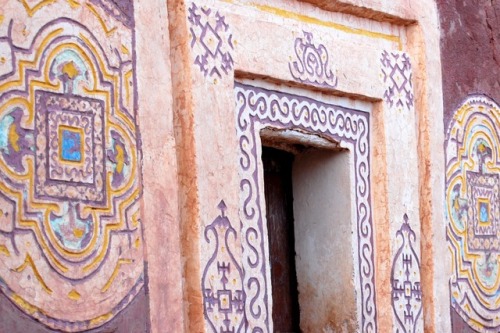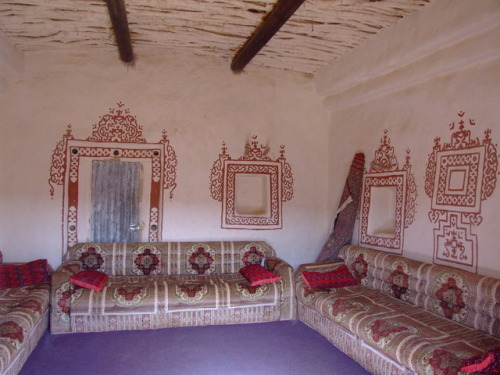black-renaissance: Oualata, Mauritania Oualata (also known as “Walata”), located in Sout
black-renaissance: Oualata, Mauritania Oualata (also known as “Walata”), located in Southeast Mauritania, is one town out of a string of 4 in total, coined by UNESCO as the Ksour (ksar - singular, ksour - plural; a Maghrebi Arabic term meaning “fortified village”) of Ouadane, Chinguetti, Tichitt and Oualata. The city of Oualata became a popular caravan city, a trading hub, between the 12th and 16th centuries CE. [1] Today it is renowned for its decorative vernacular houses.The medieval Moroccan traveler and scholar, Ibn Battuta, wrote of his stay in Oualata in his Travels in Asia and Africa 1325-1354, saying:“Thus we reached the town of Iwalatan [Walata] after a journey from Sijilmasa of two months to a day. Iwalatan is the northernmost province of the Negroes, and the sultan’s representative there was one Farba Husayn, ‘farba’ meaning deputy [in their Ianguage]. When we arrived there, the merchants deposited their goods in an open square, where the blacks undertook to guard them, and went to the farba. He was sitting on a carpet under an archway, with his guards before him carrying lances and bows in their hands, and the headmen of the Massufa behind him. The merchants remained standing in front of him while he spoke to them through an interpreter, although they were close to him, to show his contempt for them. It was then that I repented of having come to their country, because of their lack of manners and their contempt for the whites.…Later on the mushrif [inspector] of Iwalatan, whose name was Mansha Ju, invited all those who had come with the caravan to partake of his hospitality. At first I refused to attend, but my companions urged me very strongly, so I went with the rest. The repast was served–some pounded millet mixed with a little honey and milk, put in a half calabash shaped like a large bowl. The guests drank and retired. I said to them, ‘Was it for this that the black invited us?’ They answered, ‘Yes; and it is in their opinion the highest form of hospitality.’ This convinced me that there was no good to be hoped for from these people, and I made up my mind to travel [back to Morocco at once] with the pilgrim caravan from Iwalatan. Afterwards, however, I thought it best to go to see the capital of their king [of the kingdom of Mali, at the city of Mali].”He seems to have met an hateful sentiment against “white” North Africans from someone within the city. Nonetheless, he did not hate the blacks. Also by his own account (and as seen in the next excerpt), this city was inhabited by the Masufa Berbers, a tribe not known much about. The demographics of Oualata, being mostly black, could mean the Masufa are one of the few heavily black Berber tribes (the main most notably being Tuareg people), or they simply could have been the typical “white” Berbers.University of Georgia historian Timothy Cleaveland notes in his book Becoming Walata: A History of Saharan Social Formation and Transformation (2002), on page 176, that the city was inhabited by a mix of the original Mande-speaking peoples (also inhabited by Soninke people as well), and later migrations of Zenaga-speaking Berbers, followed even further down the line by Arab or “Arabized” nomads. Although, he notes that the composition of the population didn’t change very much. [2]The famous Israeli historian and expert of African Islamic history Nehemia Levtzion says in his book Ancient Ghana and Mali (1973) on page 147 that “Walata” had a mixed population of [”white”] Berbers and “Sudanese”; blacks. On pages 80 and 158, we read that it fell from its trading popularity to the city of Timbuktu in the second half of the 14th century. [3]This is what Ibn Battuta had to say of his stay in the city of Oualata, its men and the quality of their women:“My stay at Iwalatan lasted about fifty days; and I was shown honor and entertained by its inhabitants. It is an excessively hot place, and boasts a few small date-palms, in the shade of which they sow watermelons. Its water comes from underground waterbeds at that point, and there is plenty of mutton to be had. The garments of its inhabitants, most of whom belong to the Massufa tribe, are of fine Egyptian fabrics.Their women are of surpassing beauty, and are shown more respect than the men. The state of affairs amongst these people is indeed extraordinary. Their men show no signs of jealousy whatever; no one claims descent from his father, but on the contrary from his mother’s brother. A person’s heirs are his sister’s sons, not his own sons. This is a thing which I have seen nowhere in the world except among the Indians of Malabar. But those are heathens; these people are Muslims, punctilious in observing the hours of prayer, studying books of law, and memorizing the Koran. Yet their women show no bashfulness before men and do not veil themselves, though they are assiduous in attending the prayers. Any man who wishes to marry one of them may do so, but they do not travel with their husbands, and even if one desired to do so her family would not allow her to go.The women there have ‘friends’ and ‘companions’ amongst the men outside their own families, and the men in the same way have ‘companions’ amongst the women of other families. A man may go into his house and find his wife entertaining her ‘companion’ but he takes no objection to it. One day at Iwalatan I went into the qadi’s house, after asking his permission to enter, and found with him a young woman of remarkable beauty. When I saw her I was shocked and turned to go out, but she laughed at me, instead of being overcome by shame, and the qadi said to me ‘Why are you going out? She is my companion.’ I was amazed at their conduct, for he was a theologian and a pilgrim [to Mecca] to boot. I was told that he had asked the sultan’s permission to make the pilgrimage that year with his ‘companion’–whether this one or not I cannot say–but the sultan would not grant it.”In a quite hilarious situation, Battuta is surprised by this beautiful woman and attempts to flee like a nervous boy. And he does end up leaving the city of Oualata, in frustration, for Mali to see the king, and notes that it takes 24 days to reach if the caravan pushes on rapidly. [4]Citation 4 is the text provided by Fordham University’s IHSP.The renowned 15th-16th century Moroccan Berber-Andalusi writer, Leo Africanus, notes in his Descrittione dell’Africa that:“The fourth part of Africa which is called the land of Negros, beginneth eastward at the kingdome of Gaoga, from whence it extendeth west as far as Gualata.” (pg 124)“I* my selfe saw fifteene kingdoms of the Negros: howbeit there are many more, which although I saw not with mine owne eies, yet are they by the Negros sufficiently knowen and frequented. Their names there fore (beginning from the west, and so proceeding Eastward and Southward) are these following: Gualata, Ghinea, Melli, Tombuto, Gago, Guber, Agadez, Cano, Cafena, Zegzeg, Zanfara, Guangara, Borno, Gaogo, Nube.” (pg 128) [5]The last two citations are unrelated pieces written to explain what exactly this “Gaoga” kingdom was, seeing that it isn’t written of otherwise, for anyone interested.The beautiful ancient city of Oualata, Mauritania remains a notable tourist attraction today. An hour-long documentary was made about the muralist women of Oualata who decorate these houses, titled “En attandant les hommes”, in 2007 by director Katy Ndiaye.See www.walata.org if you plan to visit. Below are some extra pictures of the city (one of them shows muralists at work). Enjoy.Citations:1. http://whc.unesco.org/en/list/750/2. http://www.jstor.org/stable/256533663. http://www.sahistory.org.za/sites/default/files/file%20uploads%20/nehemia_levtzion_ancient_ghana_and_malibook4you.pdf4. http://sourcebooks.fordham.edu/halsall/source/1354-ibnbattuta.asp5. Leo Africanus, The History and Description of Africa and of the Notable Things Therein Contained: Volume 1, pgs 124 and 128, published by B. Franklin, 18966. https://academic.oup.com/afraf/article-abstract/XXIX/CXV/280/121509/THE-KINGDOM-OF-GAOGA-OF-LEO-AFRICANUS7. http://www.jstor.org/stable/180544 -- source link
Tumblr Blog : africanrenaissance.tumblr.com
#mauritania#west africa#north africa#sahara#maghreb#oualata#african history#black history#unesco#arabic#westafrica#northafrica#architecture#africancreations#blackmuslims#ethnohistory#ethnography#berber#amazigh#imazighen#tuareg#tamazight#tifinagh#history#morocco









